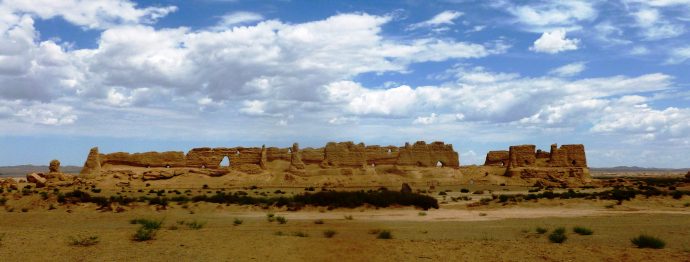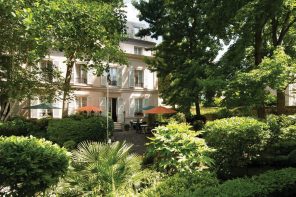Written by Seymour Topping
It had taken 20 years — and the life of at least one worker per mile — to carve through the towering Himalayan and Karakorum mountains, around hanging glaciers and across isolated valleys to build a 810-mile paved highway from Pakistan to China.
Today, this “Silk Road” trade route is the supreme challenge for the adventurous tourist, ready to spend about $6,000 for a guide and bus transport through the world’s most scenic but precipitous mountain passes, at elevations of around 15,000 feet.
Some 810 Pakistani engineers and 200 Chinese laborers died during the construction, enduring avalanches, glacial mudslides and falls from great heights. The financial cost was also staggering, about $46 billion shared by Pakistan and China, strategic allies in both Russian and Middle Eastern confrontations. Today, instead of the camel caravans, tourist buses, trucks, heavy tanks and other military equipment travel this route.
In 1979, my wife Audrey and I had the opportunity to be the first Western journalists to travel the full length of the Karakorum Highway (KKH). The New York Times Magazine had assigned us to write an article. I was then The Times’ managing editor and received permission from Gen. Muhammad Zia-ul-Haq, president of Pakistan, who had inaugurated the highway on June 18, 1978, as a “marvel of civil engineering.” He dubbed it, “the Eighth Wonder of the World.”
From our plane, the KKH resembled nothing more than a black ribbon twisting along the steep gorges of the Indus River. We were struck by the incongruity of forces — the dauntless efforts of 25,000 heroic men against the vast rock cliffs and hanging glaciers of the world’s highest mountains. In Islamabad, Zia, a compact man with dark rings around penetrating eyes and a sleek mustache welcomed us into his ornate palace for a briefing and black coffee in silver goblets. He was most noted for spreading the Muslim religion into mainstream society within Pakistan. A year earlier, Zia had overthrown Prime Minister Zulfikar Ali Bhutto in a coup called “Operation Fair Play” and declared martial law. Bhutto, a friend of the United States, was tried and executed. Then in 1988, Zia himself was believed assassinated when his airplane exploded, killing him with most of his cabinet. So much for “fair play.”
Before we left Islamabad to travel the KKH, Begum Vicky Noon, Pakistan’s flamboyant, red-haired, English-born ambassador to Portugal and wife of the vice governor of Pakistan, hosted a farewell party. The fashionable guests entertained us with tales of catastrophes, rockslides, avalanches, earthquakes and moving glaciers. Lady Noon said the cost was “One dead man per mile.” When Audrey asked if she thought it was too dangerous to proceed, she laughed and said, “Yes, of course, but isn’t that the name of the game?”
It was then with some trepidation that we boarded a sedan with an escort of armed Pakistani soldiers to travel up the spectacular, dual carriage thoroughfare, stretching north from Havelian (60 miles from Rawalpindi) in Pakistani-occupied Kashmir, upward through the Karakorum Mountains, following the trails of the rivers flowing below from the glaciers of Tibet. Instead of rolling around the mountains, like the rivers, the road tunneled under the precipices alarmingly close to the edges of steep cliffs over remote valleys. First stop was Pattan Junction, where a memorial reads: “Some time in the future when others will ply the KKH, little will they realize the amount of sweat, courage, dedication, endurance and human sacrifice that has gone into the making of this road. But as you drive along, tarry a little to say a short prayer for those silent brave men of the Pakistan Army who gave their lives to recognize a dream.”
After a night in a military camp, we passed through Swat and Kohistan in the northern areas under the shadow of the snow-capped, 26,600-foot-high Mount Na Mount Nanga Parbatt nga Parbat. Screeching to a stop to avoid being hit by a rockslide avalanching down the mountain, we heard another rumble and saw flying debris of another slide behind us. Caught in the middle!
The driver radioed for a helicopter and, after 15 minutes of hugging the mountain, we flew over K2 (Karakoram 2), the second-highest peak in the world after Mount Everest, and were rewarded with a spectacular view of 19 peaks in the Karakorams, exceeding 25,000 feet, with the spectacular hanging glaciers cascading down. Landing in a rock-strewn tableland high above the Hunza River, we were served yak-butter tea with buffalo milk by heroic workmen while we waited to get back on the road to continue along the ancient trans-Asian invasion route through Thakot, Chilas and Gilgit.
“Beyond Gilgit,” wrote a Dutch explorer in 1926, “civilization ends.” The KKH continues through remote valleys with tribes living by archaic laws who trace their ancestry to the armies of Alexander the Great, Genghis Khan and the Mughal emperors of the 12th century. The road is now safer from the fierce warriors who preyed on camel caravans by avalanching boulders and kidnapping survivors for ransom, but we had a close encounter with armed tribesmen.
The market in Kamila was filled with men in flowing robes and colorful turbans, haggling with merchants. Audrey aimed her camera at a bearded fellow buying tobacco. When he heard the camera click, he aimed his rifle at us and demanded the picture. A ring of armed men surrounded us. Our guide, Swali, kept shouting, “They are Americans, not Russians.” They marched us to the car where Audrey had a Polaroid camera. They surrounded the vehicle while I found the camera and Audrey took a photo of the red-bearded tribesman. The photo shot out of the camera and she handed it to the scowling man fingering the trigger. The photo was blank.
We jumped into the car and Audrey reached out the window to turn over the picture in his hand. We held our breath until his image gradually appeared. He gasped and roared with laughter. He had never seen a photo of himself before. Now they all wanted a photo — or else. Audrey was running out of film. She began taking their photos through the window, handing them out while we drove slowly. When the film ran out I yelled, “Step on it.” Looking back we saw them laughing at their pictures, but Swali, our blue-eyed guide who was the son of the Swali of Swat, was pale as a ghost. When I asked him why, he wiped his brow and said, “Last week they killed two Russians for less than what you did.”
The road leading to Hunza was closed so we helicoptered to the mysterious valley believed by some to be the model for James Hilton’s Shangri-La in “Lost Horizon,” where time stands still and people never grow old.
HUNZA AND SHANGRI-LA
The Old Silk Road ran through the Hunza Valley nestled between mountain peaks. We landed by the royal mausoleum near the palace. Mir (King) Ghazanfar Ali of Hunza himself greeted us. Instead of the flowing golden robe his ancestors wore, the young Mir, with green eyes and brown hair, sported a black pinstriped suit and a flashy tie. His whole demeanor was a far cry from the Royal Mirs. Prior to Pakistan’s independence from British rule in 1947, Hunza was a princely state in Kashmir and the Mir held almost absolute power. Now Hunza is governed as a Muslim administrative district in Pakistan and the Mir’s power is ceremonial.
The Mir claimed to be a descendant of Alexander the Great. Legend has it that Hunza was founded by three soldiers of Alexander’s, who took Persian wives and settled in the valley 2,000 years ago. The young Mir’s beautiful wife, Begum Shahnawaz, graduated with a degree in political science from Lahore University. When asked if the Hunzakuts really live more than 100 years, the Begum laughed and said yes, adding, “It may be the delicious wine,” which we later sampled while admiring treasures they inherited from their royal ancestors. We immediately felt much younger.
The Mir showed us an old canon positioned above the Old Silk Road. It was, he said, “used by his grandparents to demand tribute from the camel caravans. The Mir also had a collection of guitars and played in a rock band. Before leaving we signed the guest book, which looked like a Hall of Fame of explorers and royalty. Audrey was thrilled to find the name of her grandfather’s friend, the Swedish explorer Sven Hedin, and also autographs of archaeologist Aurel Stein and even Theodore Roosevelt, Lowell Thomas, Edmund Hillary and Peter Fleming .
Next morning we drove cliff-side 200 miles along the foot of the Baltoro Glacier leading to the Chinese border at Khunjerab Pass at a staggering altitude of 15,110 feet. A concrete border tower, marked 1984, was guarded by one soldier in Pakistan and one Chinese soldier in China. We had intended to cross the border to Kashgar in Xinjiang, China but a waiter in a white galabia serving sugar lumps on a silver tray to prevent altitude sickness, said the border was closed.
“Oh well,” said Audrey, “ It’s the journey not the destination.” We were rewarded by a 360- degree view of four hanging glaciers, the largest outside the Arctic Circle. Today tourists go all the way to Western China’s Xinjiang region where the KKH begins and runs through Pakistan to Gwadar on the Arabian Sea, creating a shortcut for trade with Europe. The deep water port is part of the $46 billion China says it is spending on infrastructure and power plants in the China Pakistan Economic Corridor as part of the New Silk Road now called One Band, One Road. The traffic has been recently heightened by China’s new, expanded trade program. For us the memory of the spectacular journey to the Eighth Wonder of the World would remain unique.




